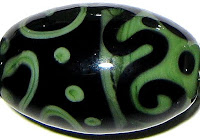Finally I'm posting these. I have two more sets sitting here on my desk but I've been just exhausted. I get to wake up tomorrow morning and assemble all of my new Ikea furniture for my workstation, which will be located outside until I figure out what to do with the shed to make it habitable.
1 - Plain (understruck), 2 - Plain (reduced), 3 - Over Clear, 4 - As a floral, 5 - w/ Silver Leaf, 6 - w/ Silver Leaf (reduced & encased), 7 - w/ Silver Glass Frit Blend (reduced) 8 - w/ Terranova2 Frit, 9 - w/ Copper Green, 10 - w/ Tuxedo, 11 - w/ Opal Yellow, 12 - w/ Ivory, 13 - w/ White
Reichenbach Mystic Coral (RL0606) is one of the most interesting colours I have tested, and I am looking forward to getting to know it even better. Lampworkers often refer to really vibrant colours as 'juicy' and this is a seriously juicy colour.
General Impressions
Mystic Coral is a striking color, but the strike is fairly easy to control. You pretty much just have to let it cool down and then give it a good warming. I deliberately understruck the first spacer bead for an interesting tangerine-on-coral shimmer. The smaller spacer was reduced, which meant it got an extra shot of heat. Reducing Mystic Coral doesn't really have much effect. As with Mystic Beige, I don't quite have a handle on how you control the transparency of this glass, but I'm going to play with it and figure it out.
Putting Mystic Coral over Clear doesn't do much to tone it down. The Clear core thins the color out just a little, but it's very dense. And gorgeous!
Reactions
In the bead on the left, the silver has darkened the surface of the Mustic Coral a fair bit, and gone sort of blue and silver and gold/yellow. I'm always intrigued when the silver doesn't ball up and leaves a sort of stain on the bead because it always makes for an interesting effect when i encase it. In the bead on the right, I applied the silver leaf, melted it in, reduced it and then encased it with Effetre Clear. I'm a little bit awestruck by the powerful blue I got when I encased it.
Silver glass colour seems to develop well on this glass. I hope it's apparent from the picture -- sometimes a glass base colour is just NFG for silver glass, and sometimes it is so wonderful that it cannot be believed. Mystic Coral is somewhere in the middle, leaning more towards the wonderful side. In both cases, the silver in the glass significantly darkened the base bead, but it's a pretty, deep red colour. I can't wait to make some real beads with this colour and give it a proper workout.
Mystic Coral and Copper Green share the same awesome reaction that Copper Green has with Lauscha Cocoa. The Copper Green separates and goes lighter wherever it is next to the Mystic Coral, which includes the Copper Green lines and dots and the place in the middle where the two colours join. With Mystic Coral, though, the reaction is even more interesting than what happens with Cocoa because the dots and lines get faintly darker around the edges in addition to the reaction that happens inside the Copper Green areas. This reaction is very much like how Copper Green behaved with Mystic Beige.
The other neat thing that happened is that the Mystic Coral lines and dots on top of the Copper Green have a sort of shampoo sheen to them.
There isn't much in the way of reaction between Mystic Coral and Tuxedo. It's kinda cool how you can see a little of the Mystic Coral on top of the Tuxedo on the left-hand side of the bead because of its odd translucency.
Mystic Coral bled into Opal Yellow a bit in the centre of this bead, but apart from that, there's not much to see here.
Mystic Coral sort of bleeds onto Ivory too, in a gentle, transparent-blushy way. Ivory looks fantastic with Mystic Coral... I think I am in love. In some of the beads at the end of this post, I used it with Reichenbach Porcelain, and that was really nice too.
These pictures are sort of awful, and I apologize for that. I have to figure out the best place to take pictures in this new space. However, here are some other beads made with Mystic Coral.




























